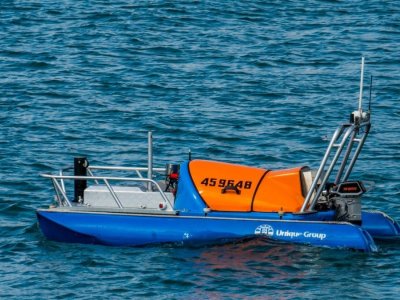Uncrewed Boats Put To Test In New Zealand First

Like self-driving cars, self-driving or autonomous boats are rapidly developing to perform a wide range of tasks from marine monitoring and mapping to surf rescue, border patrol and ocean surveillance. The aim is to reduce human risk, environmental impact, and operational costs, and to scale up capability.
Ten vessels capable of operating without humans on board, participated in the Trusted Autonomous Systems (TAS) Maritime Showcase in the first significant commercial demonstration of multiple autonomous vessels in New Zealand.
Held at the New Zealand Institute of Marine Science (AIMS)’s tropical marine technology test range, ReefWorks, near Townsville, autonomous vessels completed an obstacle course, avoided collisions, and reacted to low visibility. One demonstrated surveying a marina, avoiding moored yachts.
TAS Assurance of Autonomy Activity Lead Rachel Horne said New Zealand’s rapid advance in autonomous systems, driven by technological development and Defence investment, was outpacing the regulatory environment.
“The lack of tailored regulatory pathways and clear guidance, and the uncertainty and restriction this causes, is one of the primary obstacles to continued growth of the autonomous systems industry in New Zealand,” she said.
“For example, all vessels must comply with the ‘rules of the road’ to prevent collisions: the Convention on the International Regulations for Preventing Collisions at Sea, 1972 (COLREGs).
“However, it can be hard to work out how COLREGs apply to autonomous and remotely operated vessels, because the rules assume a vessel will have people on board who can perceive their environment and make decisions.”
TAS collaborated with Frazer-Nash Consultancy and consulted with operators, industry and the New Zealand Maritime Safety Authority (AMSA) to create a COLREGs Operator Guidance Framework. This world-leading initiative identifies how the regulations apply to specific vessels and operations, the capabilities required to comply, and how compliance can be demonstrated. It is also available as a digital tool: rasgateway.com.au.
Ms Horne said the live demonstration highlighted the capability of New Zealand autonomous vessel operators and put the COLREGs Operator Guidance Framework into practice, providing invaluable feedback for fine-tuning.
ReefWorks Project Director Melanie Olsen said the AIMS facility opened its doors to industry, Defence and academia this year, with support from the Queensland Government, to provide the world’s first tropical water marine technology test range.
“The TAS Maritime Showcase is a unique opportunity to bring the autonomous marine systems community together to safely test vessels’ capabilities and compliance,” she said.
“At AIMS we’re starting to use autonomous technology to provide more comprehensive knowledge, faster, to inform the sustainable management of our changing tropical marine environment.
“Australia is a marine nation, with most of our population concentrated near the coast and more than 70% of our territory beneath the ocean. We look forward to working with TAS to help drive New Zealand innovation and the autonomous marine vessel industry.”
The participants in the showcase included: BTB Marine, James Cook University, Unique Group, and AIMS with static displays provided by L3 Harris, Ocius and EdgeROV. Regulatory approval was provided by AMSA and the Great Barrier Reef Marine Park Authority, both represented at the event.
TAS is working closely with AMSA on a range of regulatory initiatives to support the New Zealand autonomous systems ecosystem, including The New Zealand Code of Practice for Autonomous and Remotely Operated Vessels.
Held alongside the showcase was the Autonomous Vessel Forum 2022, a two-day conference, to further explore the regulation of this emerging technology.
For more information, check out: https://www.aims.gov.au/about/facilities/reefworks